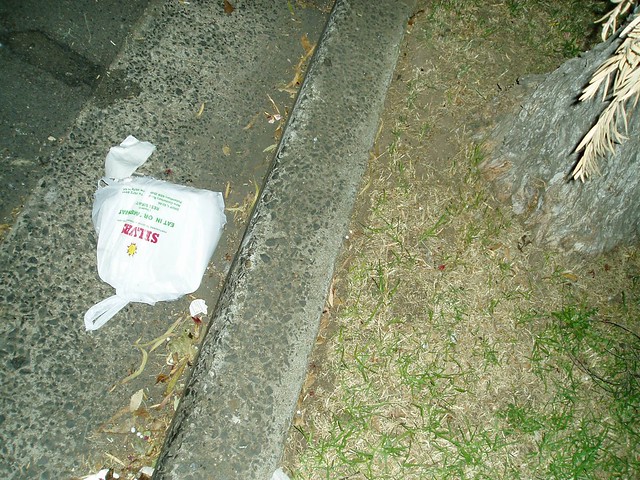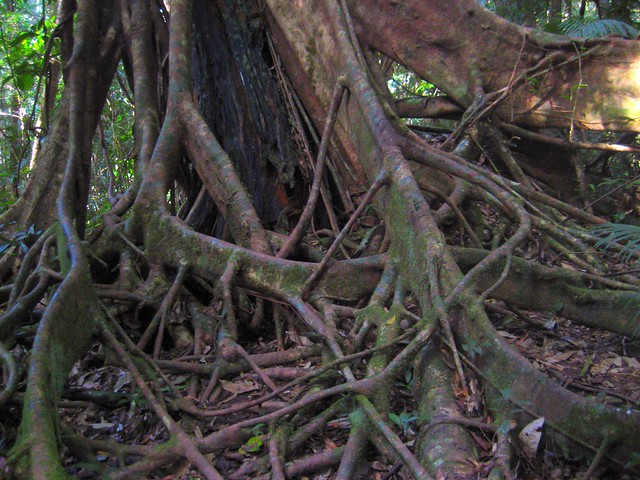Lizzie and I have just completed a whole week not working on our computers. For an umbilically cabled-in fellow like myself, this in itself is something of an achievement. But we had the added bonus of spending our unplugged time wandering through the Daintree tropical rainforest in Far North Queensland.
Now back in Sydney, sitting at my laptop with a million ‘things to do’ buzzing around my skull, it’s hard to reconnect myself to where we just were. All this busy–town stuff seems to not matter at all, when you’re standing in the middle of a forest dripping with humidity and ferns and vines and fungi and cassawaries and strangler figs. The rainforest and its inhabitants seem like a throwback to pre-historic times. The sense of disconnection I feel right now between the modern city and the rainforest is so dramatic.
 ;
;
[What is this thing? Strange rainforest organism…]
But do you have to travel to Queensland to feel this gap?A few years ago I visited Lester Bostock, an Aboriginal Elder in Marrickville, who informed me that the suburb of Petersham, where I now live, was once a forest. When you think about it, this seems so absurdly obvious as to not even need mentioning. Of course the bitumen-sealed Canterbury Road, the abandoned Majestic Roller Rink, the Portuguese Chicken Shops, and my house, haven’t always been here. There must have been something here before; and for sure, that something would have felt radically different to today’s Petersham.

[Petersham’s equivalent of “leaf litter”: gutter refuse from the local charcoal chicken outlet…]
In the city, the surface of the earth is sealed up tight with concrete, with the exception of a few parks and backyards. Water falling from the sky (and we have plenty of it in Sydney) picks up all the scunge from the roads, and then runs right off down the drain to the sewers and then who knows where. It becomes pollution: a problem to be managed (I guess this is why we are warned against swimming at the beach in Sydney after it rains).
In the far northern forests, the rain is intercepted by the topmost trees, and then filtered and trickled down and down, used again and again by countless species clambering over each other, suffocating and piggybacking and killing and dying and eating each other and bursting back to life. The rain finally soaks into the spongy compost-rich earth, then seeps down into mangrove swamps, bringing a bundle of rich nutrients and bacteria along for the ride, which in turn support the wealth of life in the creeks and river systems. The moist warm environment of the Daintree, we were told by somebody up that way (I can’t remember who), hosts about half of all the biodiversity of the entire Australian continent.
In the Permaculture course I’ve been doing, we’ve been learning about something called “functional connections”. These are precisely the way that all the elements in a system link together with each other: the outputs of one element becoming the inputs of another. In the rainforest, you can really see these connections taking place before your eyes. It’s almost impossible to isolate one particular organism and see it separated from everything else: it just doesn’t work that way.
In this environment, I felt strongly for myself – perhaps for the first time – that the forest works like a single organism. I suppose this is a bit like a micro-version the “Gaia” theory promoted by James Lovelock, who some have considered to be a neo-spiritualist nutter – that the entire planet works like a single living organism.
The real challenge, I reckon, for those of us who live in the big city, is to feel this sense of interconnectedness, here and now. How can we place ourselves within that set of “functional connections” – connections which would, inevitably, join the tropical rainforest in Far North Queensland to my tapping fingers in this wintery livingroom, heated by coal-fired electricity in suburban Petersham?



Beaut pix Lucas – love the one of the ‘forest organism’: it’s a typical fungi of forests and is undoubtedly related to ‘phallus impudicus’ or the common stinkhorn and the Agaricomycetes order. Great picture at http://en.wikipedia.org/wiki/Phallus_impudicus. It’s even edible! Not sure whether your specimen is edible…. fungi are notoriously difficult to identify 100%…. but they are sublime entities. And slimy too….
Keep tapping the fingers!
Mike xx